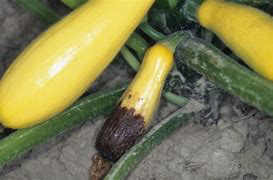Blossom End Rot is generally described as being a physiological disorder rather than a disease — caused by a deficiency of calcium. That could be caused by one of at least two conditions.
While it is most common in tomatoes, it can also occur in peppers, squash, cucumbers, and melon fruits as well.
Blossom-end rot is characterized by a large, brown to black, dry, leathery area at the blossom end of the tomato fruit. The first symptoms appear as small, water-soaked areas, which resemble bruises, on the blossom end of immature or green fruit.



Blossom end rot is caused by a calcium deficiency in developing fruit. The standard recommendation is to place a scoop of bone meal or other source of calcium in the hole prior to putting in the plant. However, that may not help if plants are set out in adverse conditions.
Blossom-end rot is most common when the growing season starts out wet and then becomes dry when fruit is setting.
It also occurs when plants are set out when the soil is too cold for them to adequately access nutrients in the soil.
- In this case, prevention consists of allowing the soil to warm before planting.
- Additionally, use fertilizers that are low in nitrogen and high in phosphorous
